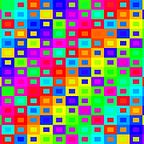Organization & Ruin
An approach to design
Humankind has defined itself by the way it builds civilizations: the Stone Age, the Bronze Age, the Industrial Age, and the Silicon Age. By all accounts, the Silicon Age is ending and we are now entering the Nano Age. History is marked by the quest to exert control over our world, today, extending down to the molecular level.
But if we’ve learned anything along the way it’s that increased order and control is met with, in equal measure, an escalated potential for uncertainty and destruction. Control is a double-edged sword.
The most transformative cultural acts waver on the knife’s edge between coming together and falling apart.
Pennsylvania.
In the realm of materials, this new alchemy is referred to as self-assembly, a phenomenon that describes how, given the right conditions, molecules reorganize into new structures all by themselves.
Creative control is handed over to matter itself in exchange for the possibility of altering the nature of the material world.
This wager radically transforms our life at the very source: the battery in your phone, the chip in your computer, the monitor you look at. These are all possible because of the reinvention of materials and the ways these materials guide energy.
“We are moving out of the world of data classification and into the world of pattern recognition.” — Marshall McLuhan, 1964
New material potentials atomize the domain of design. Everything is designable, even at the smallest scale. This motto is the basis from which our culture is transforming; it has blurred the already fuzzy edges of the discipline of architecture with daunting possibility.
Architecture, too, is an inherently destructive act. It is the physical breakdown of materials into their constituent parts, like a brick for a house or a pipe for a bathroom, standardized and recomposed into new stable structures. Architecture is a codified material system of bits and pieces intended to build and rebuild.
Destruction with the promise of renewal. Architecture has been here before.
The greatest upheavals in industry occurred at a moment exhausted by orthodoxy and technology. This moment defined architectural culture at the end of the eighteenth century. In the midst of movement forward, many voices questioned tradition.
But certain figures also remained fascinated by ruin, the soft foundation upon which to build the future.
Giovanni Battista Piranesi formed vital new structures from the fragments of previous civilizations. Assembled from fragmented sources, he conjured wild new possibilities from the rocks found in the detritus of Rome and Pompeii. These whimsical and haunting drawings of ruins reproduced and imagined new possibilities for buildings that never existed.
“Fax machines have provided architects with that final breakthrough for what they consider to be the ideal situation and that is if they’re known to be drawing they need never make their minds up.” — Cedric Price
In Gustave Doré’s painting The New Zealander, the future is a ruin to learn from. An architect from the new world sits in the foreground, sketching the old world of London in ruin. Just as Britain was once a Roman territory and British architects drew from the ruins of Rome, now noblemen from new territories may learn from the glorious remains of London.
Illustrated London News, 1864.
How these early studies of ruination became a system of formation, and how they helped architects, like Sir John Soane, rescue the discipline from an overbearing classicism, is a lesson that architects today can carry into
the future.
Both the ruin and the nanostructure share a ragged edge of possibility. The most dynamic work lies at the fringe of order and disequilibria. The place where matter unfolds unpredictably, caught between its own internal rules and the new ones it’s introduced to.
Perceiving ordered pattern is an evolutionary habit. But to push order just beyond the faculty of recognition, to introduce ruin, is a vital exercise. It is only on this ragged edge that, if you look in the right way, you may recognize the seemingly disordered structures for new formulations
of order.
Note:
This article is an excerpt from our book Trace Elements by Columbia Books on Architecture and the City.
